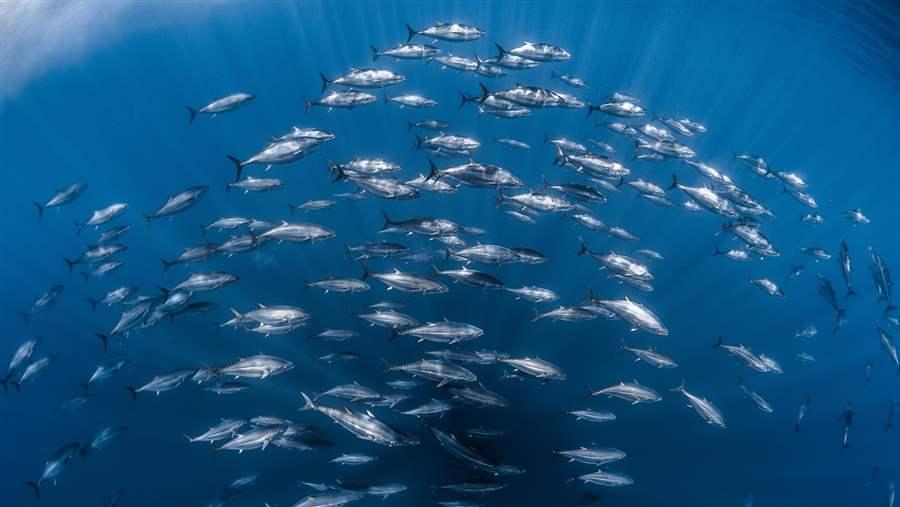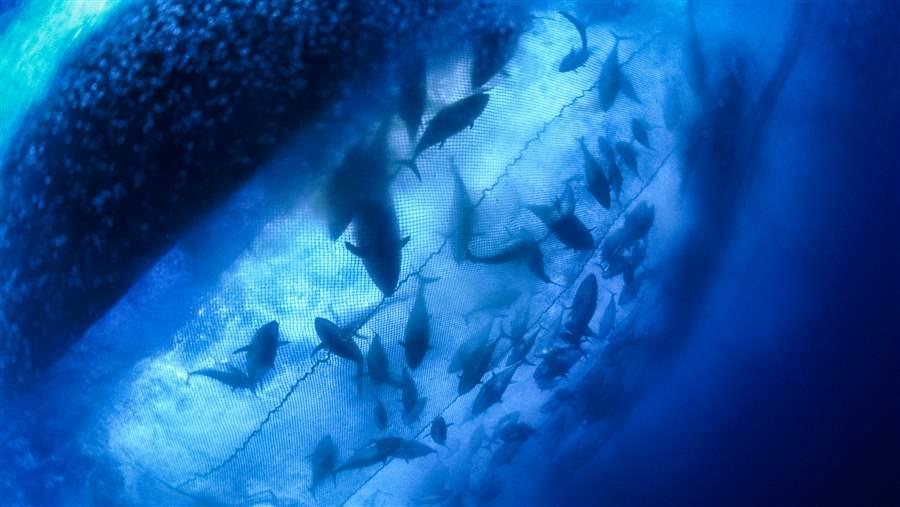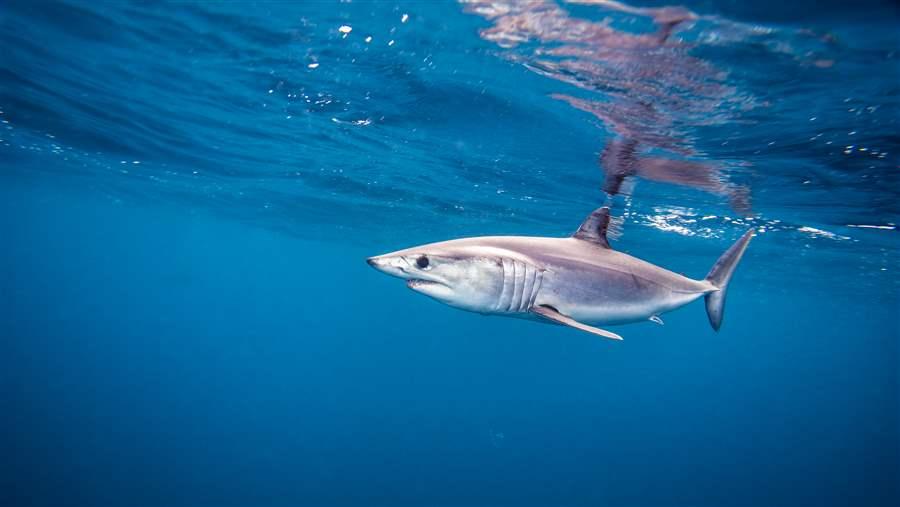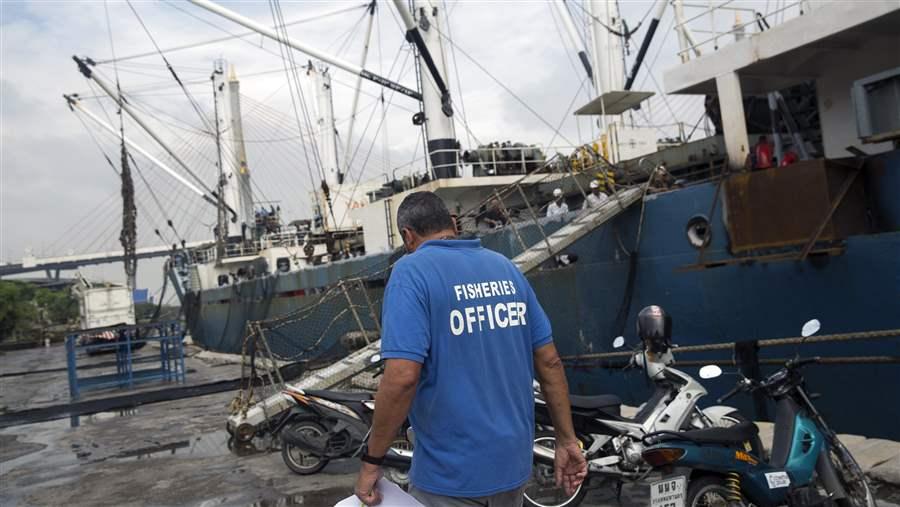Recommendations to the 25th Regular Meeting of the International Commission for the Conservation of Atlantic Tunas
14-22 November 2017, Marrakech, Morocco
Overview
The International Commission for the Conservation of Atlantic Tunas (ICCAT) is responsible for the conservation of tunas and tuna-like species in the Atlantic Ocean and adjacent seas, as well as other species caught in fisheries targeting these species.
The Pew Charitable Trusts has been encouraged in recent years by ICCAT’s move toward more science-based management and decision-making, which has led to improvements in some valuable stocks.1 However, recent decisions indicate that ICCAT may be returning to a riskier approach to management. For example, the Commission last year increased the quota for eastern Atlantic and Mediterranean bluefin tuna above the scientifically advised level for 2017, and it allowed the 2016 catch to exceed the total allowable catch (TAC) for two of ICCAT’s most economically important tuna stocks—bigeye and yellowfin—putting the recovery of both at risk.
As noted by last year’s independent performance review of ICCAT operations and fisheries management, more still needs to be done in order to end overfishing and help bigeye tuna recover; to better manage vulnerable shark populations, such as shortfin mako sharks; and to strengthen transparency in the fight against illegal, unreported, and unregulated (IUU) fishing.
Pew calls on the ICCAT contracting parties, cooperating non-contracting parties, entities, or fishing entities (hereafter referred to as CPCs) to take these critical actions at the 2017 annual meeting:
- Set precautionary, science-based catch limits for Atlantic bluefin tuna.
- Advance harvest strategies to improve long-term management, including through adoption of a harvest strategy for northern albacore.
- Amend the existing bigeye catch limit to a level that will have a high probability of rebuilding the stock.
- Adopt measures for the management of fish aggregating devices (FADs) that minimize the impact of FAD fisheries on ocean ecosystems.
- Improve the sustainability of shark populations by adopting catch limits and retention prohibitions for key species.
- Finalize and adopt amendments to the ICCAT Convention that will, among other things, obligate the Commission to manage all shark fisheries, and incorporate the precautionary approach and ecosystem-based management into its decisions.
- Increase efforts to combat IUU fishing and ensure full transparency and accountability by amending ICCAT Recommendation 2013-13 to require all eligible vessels to obtain International Maritime Organization (IMO) numbers and strengthening the IUU vessel list by allowing vessels to be listed between Commission meetings.
- Expand ICCAT Recommendation 14-09 on vessel monitoring systems (VMS) to fishing vessels of all sizes and establish a centralized system to transmit VMS data to the Secretariat.
- Apply the recommendations from the “Report of the 2nd Independent Performance Review of ICCAT” regarding port State measures.2
- Ban all transshipment at sea until such a time that best practice controls for monitoring and reporting are adopted to ensure that such activities do not contribute to IUU fishing.
Recommendations
Set precautionary, science-based catch limits for Atlantic bluefin tuna
The 2017 stock assessment for Atlantic bluefin tuna suggests that precautionary, science-based management is working, with both the eastern and western Atlantic bluefin populations exhibiting growth since the previous assessment in 2014.3
However, the new assessment proved unable to confirm recovery of the eastern stock, suggesting that, similar to 2014, the stock is still overfished in one of the three recruitment scenarios that were modeled. Although scientists have been able to resolve some of the uncertainty that plagued the 2014 assessment, ICCAT’s Standing Committee on Research and Statistics (SCRS) has warned that the 2017 results have proved highly sensitive to model assumptions and data inputs, which means they could potentially overestimate abundance.
Also, with one year left in ICCAT’s rebuilding timeline for the western Atlantic population, scientists estimated the western stock to be 18 percent of what it was in 1950 and between 45 and 69 percent of the already depleted 1974 population level. They cautioned that they expect its abundance to decline in the coming years. Furthermore, the SCRS warned that this estimate may also be inflated by various factors, most importantly the increased presence of eastern fish in western waters as the eastern stock rebuilds.
In light of the high levels of uncertainty surrounding the science, the SCRS decided not to provide managers with any estimate of how close either stock is to its recovered state (BMSY). Still, despite these worrying results and continued uncertainty, the SCRS recommended that quotas could be increased for both stocks—up to 36,000 metric tons by 2020 in the east and to 2,500 metric tons in the west—even though both of these proposed quota increases would lead to declines in abundance.
In 2016, the “Report of the 2nd Independent Performance Review of ICCAT” praised the Commission for its improved fisheries management, particularly of eastern bluefin, but stressed the need for continued precaution, especially where uncertainty exists.4 Unfortunately, ICCAT’s response was to allow the 2017 eastern bluefin quota to exceed the scientifically advised level. A recent economic analysis commissioned by Pew and The Ocean Foundation suggests that the more than 75 percent increase in the eastern bluefin quota since 2014 has led to reduced prices for all bluefin and bigeye tunas, as well as lower revenue for many tuna fishermen.5
Pew urges ICCAT to:
- Return to setting science-based catch limits for both bluefin stocks and follow through on its commitment under Resolution 15-12 to take a precautionary approach when faced with scientific uncertainty.
- At a minimum, ensure that the total quota allocated among members does not exceed the limits that scientists say will allow both stocks to continue to grow. Those limits are 28,000 metric tons or less for eastern bluefin and 1,000 metric tons or less for western bluefin.
Advance harvest strategies, including through adoption of a harvest strategy for northern albacore
Harvest strategies—also known as management procedures—are a modern management approach that increases the efficiency, transparency, and predictability of decision-making: a win for managers, the fish, and the fishing industry. The 2016 performance review concluded that ICCAT is “ideally placed to be the pioneer in the rapid introduction of long term management strategies” and encouraged the Commission to “move away from the current re-active management” to “a more pro-active policy of developing comprehensive long term management strategies for the main stocks.” ICCAT has already agreed to adopt harvest strategies for eight priority stocks by 2020,6 with northern albacore scheduled for adoption this year, Atlantic bluefin in 2018, North Atlantic swordfish in 2019, and tropical tunas in 2020.7
The June 2017 meeting of the Standing Working Group to Enhance Dialogue between Scientists and Managers (SWGSM) took a further step by developing guidance on selection of a final harvest control rule (HCR) for northern albacore.8 In October, the SCRS endorsed the management strategy evaluation (MSE) results for northern albacore as sufficiently robust and supported adoption of an interim HCR this year, contingent on a formal review of the MSE taking place after HCR adoption.9 Pew urges managers to:
Adopt an interim harvest strategy for northern albacore, including an HCR, through the process laid out by the SCRS, to ensure that ICCAT stays on track with agreed timelines.
Amend the existing bigeye catch limit to a level that will have a high probability of rebuilding the stock
In 2015, ICCAT reduced the TAC of Atlantic bigeye to 65,000 metric tons, although ICCAT scientists estimate that level to have less than a 50 percent chance of achieving the Convention objectives by 2028, already a long rebuilding timeline. This measure was risky for a stock that is both overfished and experiencing overfishing, particularly considering that the decreased quota may not result in an actual reduction in catch because of loopholes in the rebuilding plan. In addition, scientific evidence has not been presented to demonstrate that the additional management measures adopted in Recommendation 15-01 (and readopted in Recommendation 16- 01)—such as a time-area closure and a FAD monitoring limit—will contribute to ending overfishing or helping this stock recover in a timely manner.
The independent performance review done in 2016 recommended that ICCAT make bigeye recovery a “key, immediate management priority,” and said that the TAC should “be decreased further to increase the probability of rebuilding in a shorter period.” Unfortunately, ICCAT chose to ignore the advice of the review panel last year and maintained the existing quota.
The adopted rebuilding plan—with a 49 percent likelihood of success—is predicated on a quota at the 65,000 metric tons level, every year, starting in 2016. In reality, however, the 2016 catch was 72,375 metric tons, boosted by minor harvester exemptions, and there is no indication that the 2017 catch will be any lower. As such, the probability of successfully recovering Atlantic bigeye by 2028—at the 2016 catch level—has dropped to around 38 percent.
Notably, the tropical tuna measure (Recommendation 16-01) includes a requirement for ICCAT to reopen the measure if the TAC of 65,000 metric tons is exceeded in any given year. Because the TAC was exceeded in 2016, Pew reminds the Commission of its responsibility to amend the existing catch limit and urges the Commission to:
Adopt a TAC that current science indicates will achieve rebuilding with high probability (i.e. at least 70 percent) by 2024.10
Remove the provision for rollover of quota underage by major harvesters and reduce the minor harvester allowances to help ensure that this new TAC is not exceeded.
Adopt FAD management measures that minimize the ecosystem impacts of FAD fisheries
Scientists have repeatedly warned managers that the increased catch of juvenile fish associated with FADs is a primary driver of overfishing and depletion of some tropical tunas. The SCRS issued similar warnings in its 2017 management recommendations for both bigeye and yellowfin tuna.11 At least two tropical tuna stocks in the Atlantic—bigeye and yellowfin—have experienced overfishing and/or have become overfished in recent years. Without serious reform of FAD management, ICCAT managers put at risk the long-term sustainability of tropical tuna fisheries worth about US$850 million dockside annually to fishermen in the region and $3.4 billion at the final point of sale.12 Furthermore, FADs and FAD fishing have a growing impact on non-target species and coastal and pelagic marine habitats.
Last year’s independent performance review called on ICCAT to extend and expand the mandate of its FAD working group to deal with these negative impacts and to work to introduce effective FAD management into the tropical tuna fisheries, including “initiatives on limiting the number and use of FADs.” At its 2016 annual meeting, ICCAT adopted a FAD working group recommendation to task the group to directly address juvenile tuna mortality resulting from FAD use.13
This year, the FAD working group recommended that ICCAT adopt FAD management objectives and a FAD glossary to help guide FAD science and management efforts in the Atlantic.14 The SCRS also suggested action: “[S]hould the Commission wish to increase long term sustainable yield, the Committee continues to recommend that effective measures be found to reduce FAD-related and other fishing mortality.”
These recommendations mirror those made at two global meetings earlier in 2017—the independent Global FAD Science Symposium15 and the Joint tRFMO FAD Working Group Meeting.16 Those meetings generated other conclusions on FAD science and management, including the recognition that shifting some of the current purse seine fishing effort from FADs to free schools would reduce the impacts of FAD fishing on juvenile tunas, sharks, and other sensitive species if coupled with a science-based limit on the number of FADs in the water.
Given these developments, Pew urges the Commission to adopt:
- A suite of FAD management objectives that detail ICCAT’s philosophy for FAD management and provide benchmarks against which scientists can test the effectiveness of draft or final FAD management measures.
- A timeline for achieving the stated management objectives and for implementing the management recommendations of ICCAT’s FAD Working Group, the Joint tRFMO FAD Working Group, and the Global FAD Science Symposium.
ICCAT also should immediately require the SCRS to provide advice on the number of FAD sets and the total number of FADs that should be allowed in the Convention Area to achieve these management objectives and help end overfishing of bigeye as quickly as possible.
Improve the sustainability of shark populations by adopting catch limits and retention prohibitions for key species
ICCAT needs stronger protections for vulnerable and threatened shark species, and all shark catch within the Convention Area must be sustainable. The Commission should adopt the global standard of landing sharks with fins naturally attached to allow for better enforcement of its prohibition on shark finning. Pew continues to urge the Commission to apply the precautionary principle in its recommendations for shark species. Population data for these species are often limited, which leads to uncertain or inconclusive assessments. As a result, the Commission must implement measures that safeguard shark species until reliable assessments of population status can be determined.
With the adoption of Recommendation 16-12 last year, the Commission took a step forward and recognized that management actions may be needed for the blue shark (Prionace glauca), but the resulting recommendation failed to take precautionary action and pushed further decisions until the 2021 stock assessment. Despite the high level of uncertainty in the last stock assessment because of poor data, blue sharks remain a widely caught species across the Convention Area. Given the uncertainty, Pew urges the Commission to implement precautionary catch limits to safeguard this species from overfishing.
Shortfin mako (Isurus oxyrinchus) remains one of the most vulnerable shark stocks caught in the ICCAT Convention Area, based on results of the 2012 ecological risk assessment. This species is characterized by low productivity, and it is highly susceptible to being caught. According to the 2017 stock assessment, the northern stock is overfished with overfishing occurring. Although the results from the assessment of the southern stock are highly uncertain, the possibility of overfishing occurring and the stock being overfished cannot be discounted. Even if fishing pressure is reduced, the spawning stock size will continue to decline for many years because so many juveniles are being fished before reaching maturity.
Given that the stock assessment was more dire than anticipated, the SCRS noted that even with no annual catch, the stock would only have a 54 percent chance of rebuilding by 2040. The SCRS recommended a prohibition on retention as the most effective measure, along with continued monitoring and data collection. Based on the assessment results, particularly for the northern stock, Pew urges the Commission to take precautionary measures and prohibit retention of shortfin mako within the Convention Area.
Pew applauds the Commission’s action to ensure the release of live porbeagle sharks (Lamna nasus), with the adoption of Recommendation 15-06 in 2015, and encourages ICCAT to implement protective measures for this and other shark species before they see rapid declines. Science-based catch limits must be considered in order to conserve these stocks.
Given the need for precautionary management to protect these sharks, and to make progress on adopting scientifically sound conservation and management measures, Pew urges the Commission to:
- Establish concrete, precautionary catch limits for blue sharks to ensure that their populations are not overfished.
- Prohibit retention of shortfin mako sharks within the Convention Area.
Lastly, ICCAT needs to finalize amendments to its Convention that authorize management of all shark fisheries and require use of the precautionary approach and ecosystem-based management. These changes, also recommended by the independent review, will help bring ICCAT into the 21st century.
Increase efforts to combat IUU fishing and ensure full transparency and all members’ accountability to existing commitments
Illegal fishing practices are still occurring in the Convention Area, despite important steps taken by ICCAT to improve compliance with its recommendations to combat IUU fishing. In order to more effectively manage its marine resources, ICCAT must require of all members complete transparency and accountability to existing commitments. ICCAT can make progress on this front by improving its VMS requirements, harmonizing its vessel records, improving implementation of port State measures, strengthening the IUU vessel list, and banning transshipment at sea.
VMS are a powerful and commonly used tool to track authorized fishing vessels and to determine whether their activities are in compliance with requirements, such as fishing authorizations or time-area closures. Unfortunately, ICCAT’s monitoring system has significant gaps because it is applied only to certain fishing activities in the Convention Area. In addition, VMS data are not effectively used for compliance or scientific purposes. ICCAT would benefit from expanding VMS requirements across all managed species so procedures are better aligned with those already in place for eastern Atlantic and Mediterranean bluefin tuna.
In 2014, the Commission required that flag States increase the information transmission frequency or polling rate from every six to every four hours and that they ensure that VMS data are shared with coastal States when vessels are in foreign exclusive economic zones, two signs of progress. However, the Commission should take further steps recommended by the SCRS. For example, the frequency of VMS data polling should be increased to every hour or less, and vessels should be required to transmit VMS data to the ICCAT Secretariat via their flag State’s Fishing Monitoring Center.
Additional steps also can be taken to ensure the identification of all fishing vessels. Since 1 January 2016 when Recommendation 2013-13 entered into force, vessels at least 20 meters in length overall and all vessels fishing for eastern Atlantic and Mediterranean bluefin tuna have been required to have IMO numbers. That has helped the Secretariat continue to improve the quality of its Record of Vessels by clearly identifying active vessels. In addition, although CPCs have made great progress in providing IMO numbers for most active vessels when required, gaps remain.
The CPCs should ensure that none of their vessels required to have IMO numbers are fishing without this identification. In addition, IMO numbers should be checked and clearly marked in each vessel’s records.
In August 2016, the IMO amended its guidance on eligibility criteria for IMO numbers. Fishing vessels of non- steel hull construction of 100 gross tons and above, and all motorized inboard fishing vessels of less than 100 gross tons down to a size limit of 12 meters in length overall, that are authorized to operate outside waters under national jurisdiction are now eligible. This means that more than 1,500 additional vessels listed on the ICCAT Record of Vessels are now eligible.17 Accordingly, the Secretariat is encouraged to amend Recommendation 2013- 13 to include all eligible fishing vessels.
Port State measures are widely recognized as cost-effective controls, effective in the fight against IUU fishing. The ICCAT Scheme for Minimum Standards for Inspection in Port (Recommendation 12-07) is an essential starting point for implementation of port State measures but could be extended to align more closely with the Food and Agriculture Organization’s Port State Measures Agreement (PSMA)—the first legally binding international treaty specifically targeting IUU fishing. Several of ICCAT’s CPCs are already party to the agreement. Steps to increase those numbers and improve implementation of the PSMA would be beneficial.
The ICCAT Record of Vessels is an essential tool to ensure adequate monitoring of fishing activities. As such, it should incorporate other information that can help national authorities in control and enforcement actions, including risk analyses. In this regard, all the CPCs should be required to supply information on any enforcement action taken against any authorized vessel, such as fines, detentions, or catch confiscations; this information should be reflected in the record as soon as it is available.
Placing a vessel on ICCAT’s IUU vessel list helps to deter unacceptable practices in the Convention Area. However, current rules only allow the Secretariat to add vessels to the list once a year. That allows some to operate unhindered until action is taken by the Commission at its annual meeting. ICCAT already has procedures that permit delisting of vessels between annual meetings. The commission should amend its rules to allow vessels to be listed on an intersessional basis as well. ICCAT should be able to update the IUU vessel list whenever a vessel changes name, flag, or other identifying feature.
In order to better combat IUU fishing and ensure full transparency and accountability to existing commitments for all members, Pew urges the Commission to:
- Require all authorized fishing vessels, including non-CPC flagged vessels, to have fully operative, tamper-proof VMS.
- Create a centralized system for transmitting required VMS data to the Secretariat, which would make all data available to relevant concerned States and ICCAT bodies.
- Amend Recommendation 2013-13 to require that all eligible vessels obtain an IMO number.
- Consider adding other information to the Record of Vessels that can be useful for control and enforcement purposes, such as the details on any enforcement action taken on a vessel.
-
Apply recommendations of the “Report of the 2nd Independent Performance Review of ICCAT” regarding port State measures to:
- Encourage CPCs to become contracting parties to the PSMA.
- Amend Recommendation 12-07 to ensure more consistency with the PSMA, in particular by including definitions and requiring the CPCs to impose key port State measures such as denial or use of port in certain scenarios.
- Closely follow the Indian Ocean Tuna Commission’s efforts to enhance effective implementation of its port State measures through its electronic port State measures (e-PSM) system, and adopt similar efforts within ICCAT where appropriate.
- Make more efforts to assess substantive compliance with its port State measures and to specify consequences for non-compliance.
- Establish a procedure that permits the listing of IUU vessels between annual meetings, and take action to ensure that the list is updated whenever a vessel changes name, flag, or any other identifying element.
Ensure that transshipment activities do not contribute to IUU fishing
Transshipment at sea, particularly on the high seas, continues to provide opportunities for illegally caught fish to be unloaded onto carrier vessels, which facilitates the laundering of catches into legitimate supply chains. The Commission recognized the link between transshipment, IUU fishing, and laundering of illegally caught fish in Recommendation 16-15 and instituted an ICCAT Record of Carrier Vessels, an authorized carrier vessel list. It also requires that all carrier vessels carry an observer.
However, these initiatives alone cannot ensure that all illegal activities can be detected or deterred. Currently, any non-contracting party Party (NCP) can register a flagged carrier vessel on the Record of Carrier Vessels, which allows NCP carriers to land and possibly launder catches taken from ICCAT waters, because NCPs are not required to ensure compliance with ICCAT’s Catch or Statistical Document Program or other ICCAT recommendations.
ICCAT should immediately close this loophole by removing the ability for NCP-flagged carrier vessels to be listed on the ICCAT-authorized vessel record.
In addition, ICCAT should immediately require that all fishing vessels carry an observer before the vessel can participate in transshipment activities. The Commission also must ensure that best practices are followed to comply with requirements for timely notifications to all relevant authorities and observer reporting. Until all these measures are adopted, transshipment at sea should be banned in the ICCAT Convention Area.
Pew urges the Commission to:
- Ban all transshipment at sea until a full range of best practice controls, monitoring, and reporting have been adopted to ensure that activities do not contribute to IUU fishing.
-
In the absence of a complete ban, add the following additional control measures:
- Remove the ability for non-CPC flagged carrier vessels to be listed on the ICCAT Record of Carrier Vessels.
- Require that all fishing vessels carry an observer before the vessel can participate in transshipment activities.
Endnotes
- The Pew Charitable Trusts, “Following the Science is Critical for Atlantic Fish Stocks” (June 2017), http://www.pewtrusts.org/en/ multimedia/data-visualizations/2017/following-the-science-is-critical-for-atlantic-fish-stocks.
- International Commission for the Conservation of Atlantic Tunas, “Report of the 2nd Independent Performance Review of ICCAT” (2016), https://www.iccat.int/Documents/Other/0-2nd_PERFORMANCE_REVIEW_TRI.pdf.
- International Commission for the Conservation of Atlantic Tunas, “Report of the 2017 ICCAT Bluefin Stock Assessment Meeting” (2017), http://iccat.int/Documents/Meetings/Docs/2017_BFT_ASS_REP_ENG.pdf.
- International Commission for the Conservation of Atlantic Tunas, “Report of the 2nd Independent Performance Review of ICCAT.”
- Chin-Hwa Jenny Sun et al., “More Landings for Higher Profit? Inverse Demand Analysis of the Bluefin Tuna Auction Price in Japan and Economic Incentives in Global Bluefin Tuna Fisheries Management,” accessed Sept. 7, 2017, http://www.iae.ntou.edu.tw/RePEc/nto/wpaper/201701.pdf.
- International Commission for the Conservation of Atlantic Tunas, “Recommendations by ICCAT on the Development of Harvest Control Rules and of Management Strategy Evaluation,” https://www.iccat.int/Documents/Recs/compendiopdf-e/2015-07-e.pdf.
- International Commission for the Conservation of Atlantic Tunas, “Draft Road Map for the Development of Management Strategy Evaluation (MSE) and Harvest Control Rules (HCR),” proposal submitted by the United States and the European Union (2016), https:// www.iccat.int/com2016/DocENG/PLE_137B_ENG.pdf.
- International Commission for the Conservation of Atlantic Tunas, “Report of the Third Meeting of the Standing Working Group to Enhance Dialogue Between Fisheries Scientists and Managers (SWGSM)” (2017), http://iccat.int/Documents/Meetings/Docs/2017_SWGSM_REP_ENG.pdf.
- International Commission for the Conservation of Atlantic Tunas, “Report of the Standing Committee on Research and Statistics (SCRS) (Madrid, Spain 2 to 6 October 2017)” (2017), http://iccat.int/Documents/Meetings/Docs/2017_SCRS_REP_ENG.pdf.
- This is the approximate year when two generation times will have passed since the 2015 assessment determined the stock to be significantly overfished.
- International Commission for the Conservation of Atlantic Tunas, “Report of the Standing Committee on Research and Statistics (SCRS).”
- Grantly Galland, Anthony Rogers, and Amanda Nickson, The Pew Charitable Trusts, “Netting Billions: A Global Valuation of Tuna” (2016), http://www.pewtrusts.org/tunavalue.
- International Commission for the Conservation of Atlantic Tunas, “Recommendation by ICCAT to Establish an Ad Hoc Working Group on Fish Aggregating Devices (FADs)” (2016), http://iccat.int/Documents/Recs/compendiopdf-e/2016-02-e.pdf.
- International Commission for the Conservation of Atlantic Tunas, “Report of the Standing Committee on Research and Statistics (SCRS): Report of the Third Meeting of the Ad Hod Working Group on FADs,” 255.
- John Hampton et al., “What Does Well-Managed FAD Use Look Like Within a Tropical Purse Seine Fishery?” Joint t-RFMO FAD Working Group Meeting, Document No. j-FAD_35/2017 (2017), https://meetings.iccat.int/index.php/s/VOCt7mjI0aduZCl?path=/ENG.
- International Commission for the Conservation of Atlantic Tunas, “Chair Report of the 1st Joint Tuna RFMO FAD Working Group Meeting” (2017), http://iccat.int/Documents/Meetings/Docs/2017_JFADS_REP_ENG.pdf.
- Number of fishing vessels over 12 meters in length, below 100 gross tons, listed on the ICCAT Record of Vessels via the Consolidated List of Authorized Vessels.
For further information, please visit: pewtrusts.org
















